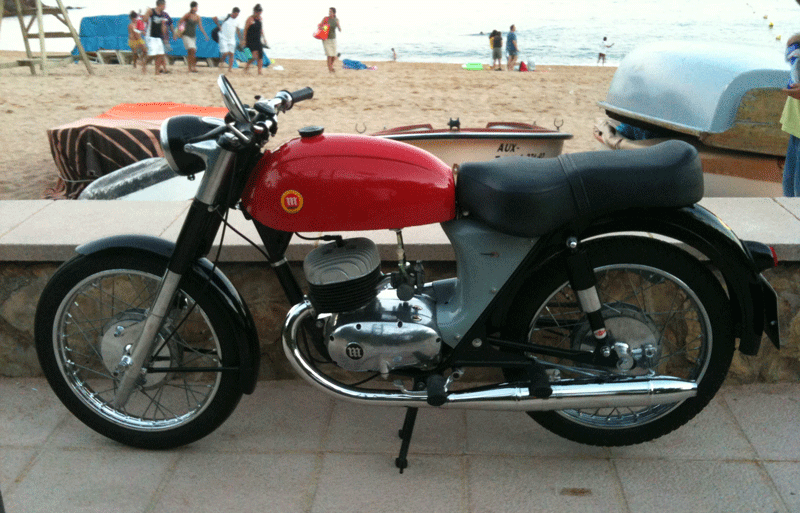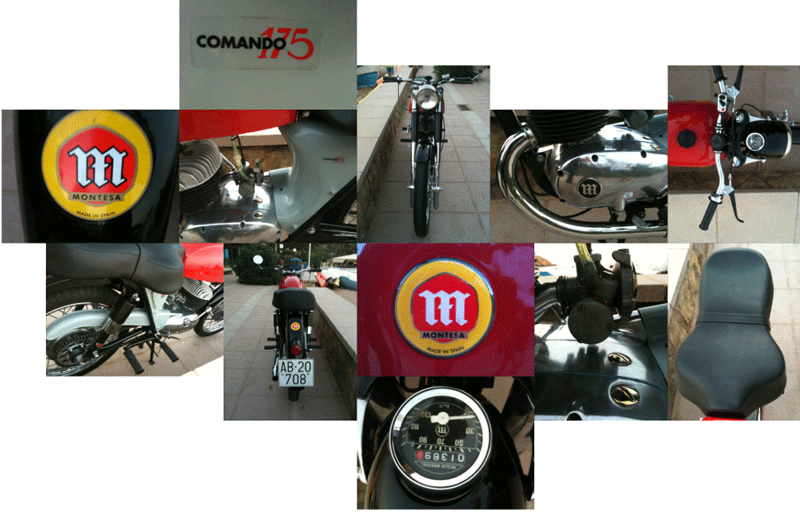September 7, 2010
Patrick's Montesa Comando 175

My friend Patrick Alier works for LS2 in Barcelona as an industrial designer of motorcycle helmets. He recently showed me his restored Montesa Comando 175. The story of the bike goes deep into the history of 20th Century Barcelona, of how it recuperated its fabled first industrial revolution (textiles) after the disaster of the Civil War and the poverty of the Franco years with the production of motorcycles in an alliance with Japan's Honda corporation. "It's a... pure... Catalan... bike, Dennis! Total Catalan ingenuity! Total.", he said musically in his French accent as we sipped our drinks at Kiko and Lourdes' wedding reception. Patrick told the story with such passion and force that I will not be able to reproduce it here, so let me boot to a cut and paste job from Wikipedia and PhotoShop razzmatazz to simulate for you dear reader what it must have been like to hear Patrick's story from his lips and to see his bike in person:
Montesa was Formed in 1944 by Pedro Permanyer and Francisco Xavier "Paco" Bult?. Their first Montesa prototype was based upon the French Motob?cane models of that time. Permanyer began to produce his own gas engines, which allowed for a new area in motorcycles to be explored and expanded into. Permanyer and Bult? teamed up in Barcelona and created a light-weight motorcycle. This led to the creation of a bike powered by a 95cc two-stroke engine with no rear suspension. Despite some setbacks, they sold 22 of these units in the first year of production. The next year, the partnership focused on production improvements and meeting the growing demand for their bike. As a successor to the previous model, Bult? designed a new 125cc roadster, which was tested in many the trail-type rallies and semi-enduros that were popular in Spain at the time.This model went on to enter the 1951 International Six Days Enduro. The bike was entered in by the factory, being ridden by Bult? and G. Cavestany. In the early 1950s, Montesa entered many races in the 125cc class of road racing. These bikes featured six-speed, bolt on gearboxes, in semi-unit construction, with all gears running on needle-roller bearings. By 1956, these Montesa 125s were very competitive and took second, third and fourth places in the Ultra-Lightweight race at the Isle of Man TT.
The most successful Montesa street bike of the '50s was the Brio 80, of which more than 12,000 were produced. The success of the Brio and the other models, led to the opening of a new and larger factory in Espluges de Llobregat. The Brio 80 and Brio 90 models contained many new advances, such as moving the carburetor behind the cylinder, and a handbrake. However, a slump in the Spanish economy had forced Permanyer to cut back on the company's racing activities. Permanyer wanted to pull out of road racing, but Bult? insisted that they stay in. In May 1958, chief designer Bult? left, taking with him several of Montesa's vital personnel. Permanyer had not only lost the brilliant designer Bult?, but also his 30% share of the company.
Fortunately for both, Spain's economy began to improve. Permanyer promoted the all-around champion motorcyclist Pedro Pi from head test rider to chief development engineer. Leopold Mila was made Technical Director and Permanyer's son Javier, was to be Sports Assistant. Work began right away on designing a brand new all-unit-construction 175cc engine that by 1960, would power the latest Impala sports roadster model. This engine would form the basis of the company's future trials and motocross machines. To promote sales of this model, three Impala's were taken to Africa where they covered over 12,000 miles of terrain, most of it being off-road. Back in Spain, Pi was busy winning the Spanish motocross and road race championships and working on a new 250cc version.
Following its introduction in 1965, the 250 engine would be the cornerstone of the company's future success. Mounted on the new 250 Scorpion scrambler, Pi won the Spanish championship again in 1966 and the similarly engined Sport roadster won the Barcelona 24-hour endurance road race. In 1967 the first Montesa trials models appeared and in 1968 retitled the Cota, Pi won the Spanish Trials Championship. After adding this title to go along with the road race and six motocross titles, he retired from competition to devote his full energy to bike development.
In the decade following, Montesa had unprecedented growth around the World and one has to remember that unlike Bulto's bike, the Bultaco, Montesa only sent a small percentage of its production to the States, concentrating mostly on the European market.

Leave a comment